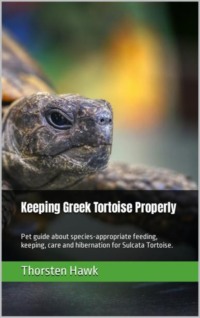Loe raamatut: «Keeping Greek Tortoise Properly»
Keeping Greek Tortoise Properly
By Thorsten Hawk
contents
Guide on Greek tortoise husbandry
1. Overview of tortoise species
2. Characteristics of a Greek tortoise
Look
offspring and rearing
lifestyle and behavior
communication and sensory performance
nutrition
attitude
3. Loner or group?
4. Behavior and Sounds
Sounds
5. Before you buy
6. Transportation home
7. Terrarium, size and location
8. Basic equipment in the terrarium
The right lighting
The floor
The right terrarium planting
Appropriate measuring devices
water and food source
9. Optimum temperatures and humidity
10. Diet and Water
fruit and vegetables
Other unsuitable foods
finished food
vitamins
Fresh water
11. Fresh food from nature
12. Care and cleaning
13. Sleeping habits
14. Hibernation and forage
15. This is what tortoises are afraid of
16. What do tortoises like
17. Employment
18. Registration of tortoises
19. Common diseases and first aid
Guide on Greek tortoise husbandry
Tortoises are not only beautiful animals, but also extremely interesting, not without reason, they are an increasingly popular pet among people and can even be partially tamed. Greek and European tortoises live on average 70 years.
The giant tortoise on the Seychelles even manages to live up to 100 years. In Cairo there is said to have been a Galapagos giant tortoise, which sadly died in 2006 and lived to an unbelievable 270 years old. If you want to keep tortoises, you should keep them as close to nature and as species-appropriate as possible.
This not only means that the tortoise needs enough space and regular exercise, but also that it has the opportunity to hibernate. Tortoises also have their own individual needs when it comes to care and nutrition and, for example, they are not allowed to eat all the fresh fruit and vegetables that are available, as many tortoise owners often do wrong.
I have taken the trouble to write this very detailed and really comprehensive guide so that your turtle will not lack anything later and can lead a healthy long life. In this guide you will not only find out everything about keeping, lifestyle and nutrition, I will also go into specific things like how best to transport your tortoise, where you register your tortoise or what diseases can occur if you do not keep it in a species-appropriate manner.
But that's not all, here you can find out everything you should or want to know about your new pet.
1. Overview of tortoise species
Unfortunately, most tortoises are threatened by humans in their usual and natural habitat. For this reason, the animals are also under very special protection. Probably the most famous tortoise is the Galápagos giant tortoise, which can reach an incredible size of over 130 cm.
The phanter tortoise is 50 cm long and can even be kept at home under certain conditions. But not only these other species can reach incredible sizes and are more suitable for beginners or smaller areas.
The 5 most popular are probably:
Greek tortoise (Testudo hermanni) Marginated tortoise (Testudo marginata) Moorish tortoise ( Testudo graeca) Collapsible tortoise (Malacochersus tornieri) Panther tortoise (Stigmochelys pardalis)
The Greek tortoise is about 25 cm long and is probably the most popular choice of tortoise in German households.
Tasuta katkend on lõppenud.
